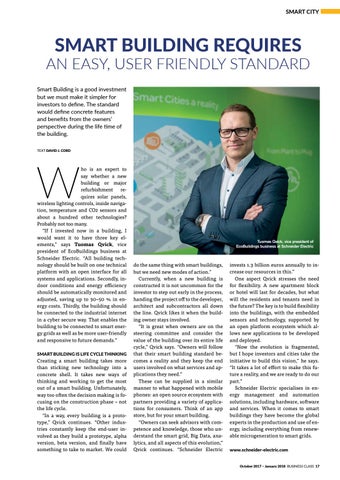SMART CITY
SMART BUILDING REQUIRES
AN EASY, USER FRIENDLY STANDARD Smart Building is a good investment but we must make it simpler for investors to define. The standard would define concrete features and benefits from the owners’ perspective during the life time of the building. TEXT DAVID J. CORD
W
ho is an expert to say whether a new building or major refurbishment requires solar panels, wireless lighting controls, inside navigation, temperature and CO2 sensors and about a hundred other technologies? Probably not too many. “If I invested now in a building, I would want it to have three key elements,” says Tuomas Qvick, vice president of EcoBuildings business at Schneider Electric. “All building technology should be built on one technical platform with an open interface for all systems and applications. Secondly, indoor conditions and energy efficiency should be automatically monitored and adjusted, saving up to 30–50 % in energy costs. Thirdly, the building should be connected to the industrial internet in a cyber secure way. That enables the building to be connected to smart energy grids as well as be more user-friendly and responsive to future demands.” SMART BUILDING IS LIFE CYCLE THINKING
Creating a smart building takes more than sticking new technology into a concrete shell. It takes new ways of thinking and working to get the most out of a smart building. Unfortunately, way too often the decision making is focusing on the construction phase – not the life cycle. “In a way, every building is a prototype,” Qvick continues. “Other industries constantly keep the end-user involved as they build a prototype, alpha version, beta version, and finally have something to take to market. We could
Tuomas Qvick, vice president of EcoBuildings business at Schneider Electric
do the same thing with smart buildings, but we need new modes of action.” Currently, when a new building is constructed it is not uncommon for the investor to step out early in the process, handing the project off to the developer, architect and subcontractors all down the line. Qvick likes it when the building owner stays involved. “It is great when owners are on the steering committee and consider the value of the building over its entire life cycle,” Qvick says. “Owners will follow that their smart building standard becomes a reality and they keep the end users involved on what services and applications they need.” These can be supplied in a similar manner to what happened with mobile phones: an open source ecosystem with partners providing a variety of applications for consumers. Think of an app store, but for your smart building. “Owners can seek advisors with competence and knowledge, those who understand the smart grid, Big Data, analytics, and all aspects of this evolution,” Qvick continues. “Schneider Electric
invests 1.3 billion euros annually to increase our resources in this.” One aspect Qvick stresses the need for flexibility. A new apartment block or hotel will last for decades, but what will the residents and tenants need in the future? The key is to build flexibility into the buildings, with the embedded sensors and technology, supported by an open platform ecosystem which allows new applications to be developed and deployed. “Now the evolution is fragmented, but I hope investors and cities take the initiative to build this vision,” he says. “It takes a lot of effort to make this future a reality, and we are ready to do our part.” Schneider Electric specialises in energy management and automation solutions, including hardware, software and services. When it comes to smart buildings they have become the global experts in the production and use of energy, including everything from renewable microgeneration to smart grids. www.schneider-electric.com October 2017 – January 2018 BUSINESS CLASS 17
